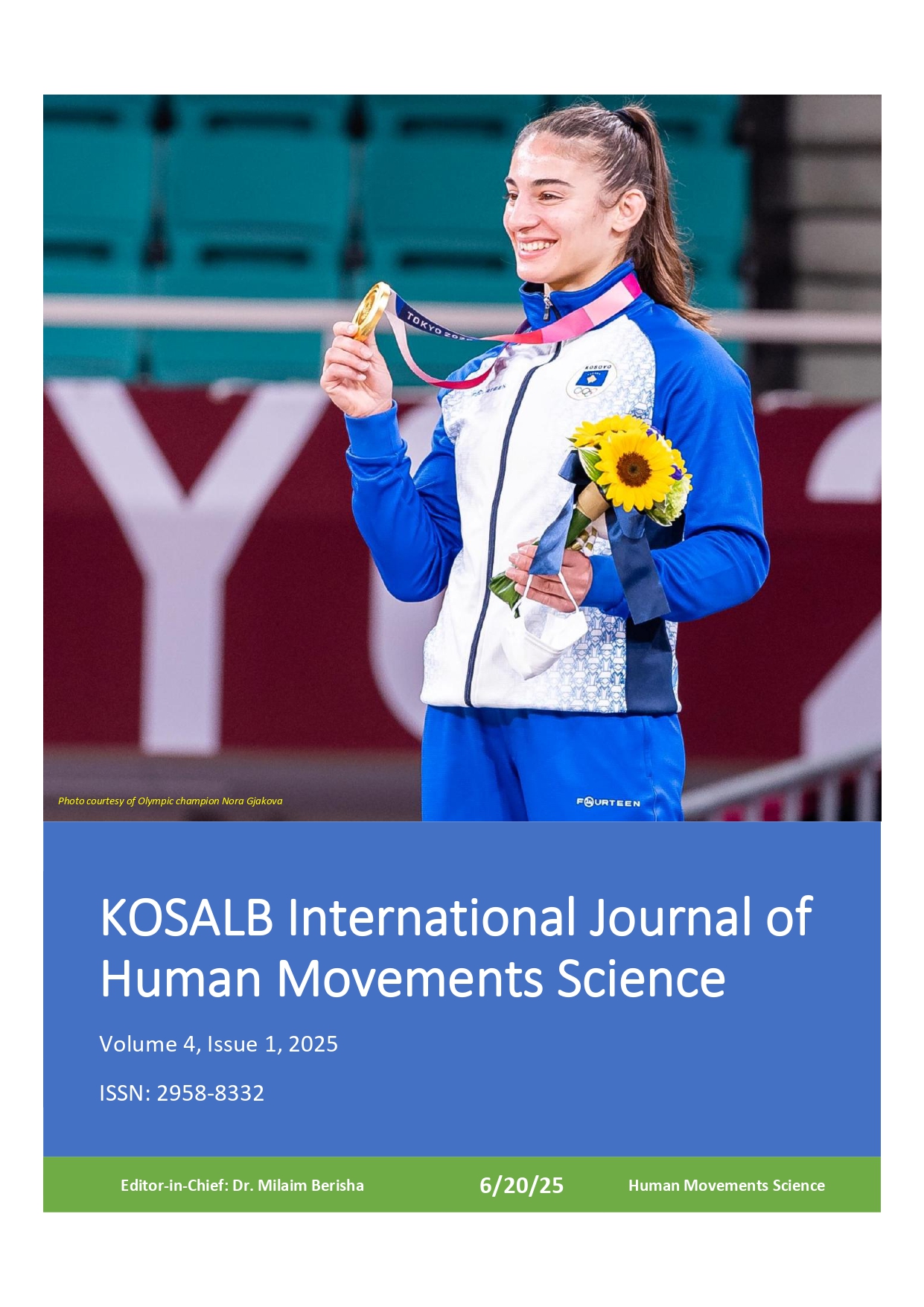Analysis of Indicators of Loneliness and Their Relationship with Physical Activity Levels in Kosovo
DOI:
https://doi.org/10.70736/2958.8332.kosalb.50Keywords:
Loneliness, Physical Activity, Gender, Parental Impact, Residence, Marital StatusAbstract
Study aim(s): This study aims to examine the prevalence of loneliness among adults in Kosovo, with a focus attention to gender, place of residence, marital status, and lifestyle habits. Additionally, it seeks to analyze the relationship between physical activity levels and experiences of loneliness.
Methods: A total of 128 participants completed a demographic questionnaire, along with two standardized instruments: the UCLA Loneliness Scale and the International Physical Activity Questionnaire (IPAQ). Data were collected virtually following ethical approval, and participation was entirely voluntary.
Results: This study found no statistically significant differences in overall levels of loneliness based on gender, place of residence, or lifestyle. However, responses to specific questions indicated that women exhibited higher levels of sensitivity. Notably, individuals in relationships reported higher levels of loneliness than those who were married or single. Regarding physical activity, men were generally more active than women, and rural residents engaged in more strenuous forms of exercise. A particularly important finding was that walking for more than 10 minutes per day had a positive and statistically meaningful impact on reducing feelings of loneliness.
Conclusion: The findings support the importance of promoting physical activity and suggest that incorporating at least a daily walk may serve as an effective strategy for preventing and managing loneliness.
References
Heinrich, L. M., & Gullone, E. (2006). The clinical significance of loneliness: A literature review. Clinical Psychology Review, 26(6), 695–718, DOI: https://doi.org/10.1016/j.cpr.2006.04.002.
Yanguas, J., Pinazo-Henandis, S., & Tarazona-Santabalbina, F. J. (2018). The complexity of loneliness. Acta Biomedica, 89(2), 302–314. https://pmc.ncbi.nlm.nih.gov/articles/PMC6179015/.
Cacioppo, J. T., & Cacioppo, S. (2018). The growing problem of loneliness. The Lancet, 391(10119), 426. https://pmc.ncbi.nlm.nih.gov/articles/PMC6530780/.
Korzhina, Y., Hemberg, J., Kurkiala, P., & Fagerström, L. (2022). Causes of involuntary loneliness among adolescents and young adults: An integrated review. International Journal of Adolescence and Youth, 27(1), 509–522, DOI: https://doi.org/10.1080/02673843.2022.2150088
Wiseman, H., Guttfreund, D. G., & Lurie, I. (1995). Gender Differences in Loneliness and Depression of University Students Seeking Counseling. British Journal of Guidance & Counseling, 23, 231-243, DOI: http://dx.doi.org/10.1080/03069889508253008
Heshmati, S., Blackard, B., Beckmann, M., Chipidza, B., & Wallace, M. (2021). Family relationships and adolescent loneliness: An application of social network analysis in family studies. Journal of Family Psychology. https://psycnet.apa.org/record/2021-36797-007.
Verity, L., Schellekens, T., Adam, T., Sillis, F., Majorano, M., Wigelsworth, M., ... & Qualter, P. (2021). Tell Me about Loneliness: Interviews with Young People about What Loneliness Is and How to Cope with It. International Journal of Environmental Research and Public Health, 18(22), 11590. https://pmc.ncbi.nlm.nih.gov/articles/PMC8621930/.
Piggin, J. (2020). What is physical activity? A holistic definition for teachers, researchers and policy makers. Frontiers in Sports and Active Living, 2, 72, DOI: https://doi.org/10.3389/fspor.2020.00072.
Seefeldt, V., Malina, R. M., & Clark, M. A. (2002). Factors affecting levels of physical activity in adults. President's Council on Physical Fitness and Sports Research Digest, 3(14), 1–8, https://pubmed.ncbi.nlm.nih.gov/11839079/.
Kokkinos, P. (2012). Physical activity, health benefits, and mortality risk. ISRN Cardiology, 2012, Article ID 718789. DOI: https://doi.org/10.5402/2012/718789.
Paluska, S. A., & Schwenk, T. L. (2000). Physical activity and mental health. Sports Medicine, 29(3), 167–180, DOI: https://doi.org/10.2165/00007256-200029030-00003.
World Health Organization. (2022). Physical activity. Geneva: World Health Organization. Retrieved from https://www.who.int/news-room/fact-sheets/detail/physical-activity.
QHPSM. Basic package of instruments for school psychologists and pedagogues. 2021.
IPAQ Research Committee. Guidelines for data processing and analysis of the International Physical Activity Questionnaire (IPAQ) – short and long forms [Internet]. 2005 https://youthrex.com/wp-content/uploads/2019/10/IPAQ-TM.pdf.
Maes, M., Qualter, P., Vanhalst, J., Van den Noortgate, W., & Goossens, L. (2019). Gender differences in loneliness across the lifespan: A meta–analysis. European Journal of Personality, 33(6), 642–654. DOI: https://doi.org/10.1002/per.2220.
Brestovci, S. B., Morina, B., Georgiev, G., & Gontarev, S. (2021). Gender differences in social cognitive factors and physical activity of Kosovo college students. Journal of Physical Education and Sport, 21(5), 2165–2172. https://www.efsupit.ro/index.php/archive?id=127.
Fan, J. X., Wen, M., & Kowaleski-Jones, L. (2014). Rural–urban differences in objective and subjective measures of physical activity: findings from the NHANES 2003–2006. Preventing Chronic Disease, 11, E141. https://pubmed.ncbi.nlm.nih.gov/25144676/.
Liu, H., Copeland, M., Nowak, G., Chopik, W. J., & Oh, J. (2023). Marital status differences in loneliness among older Americans during the COVID-19 pandemic. PLOS ONE, 18(2), e0282080. https://pubmed.ncbi.nlm.nih.gov/38264508/.
Singh, S., & Srivastava, N. (2024). Loneliness and satisfaction with life among young adults belonging to nuclear and joint families. The International Journal of Indian Psychology, 12(1), 1427–1435. https://ijip.in/articles/loneliness-and-satisfaction/.
Augustijn, L. (2020). The intergenerational transmission of loneliness between parents and their adult children. BMC Public Health, 20, 1223. https://ubp.uni-bamberg.de/jfr/index.php/jfr/article/view/365.
Ekkekakis, P., Hall, E. E., VanLanduyt, L. M., & Petruzzello, S. J. (2000). Walking in (affective) circles: Can short walks enhance affect? Journal of Behavioral Medicine, 23(3), 245–275. https://pubmed.ncbi.nlm.nih.gov/10863677/
Downloads
Published
How to Cite
Issue
Section
License
Copyright (c) 2025 KOSALB International Journal of Human Movements Science

This work is licensed under a Creative Commons Attribution-NonCommercial 4.0 International License.




